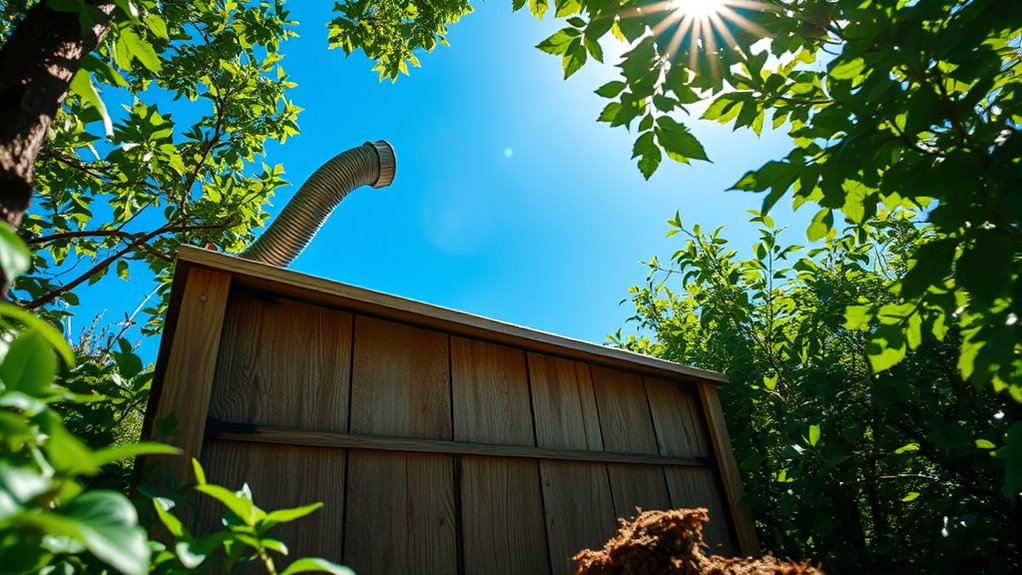Composting toilets help you manage waste sustainably by turning human waste into safe, nutrient-rich compost without water. They’re ideal for travelers wanting eco-friendly solutions, offering options like portable or self-contained units that are easy to use and maintain. Proper ventilation, bedding materials, and regular cleaning are key to odor control and hygiene. If you want to learn how to use, maintain, and get the most out of composting toilets on the go, there’s more to discover below.
Key Takeaways
- Composting toilets separate waste from water, turning it into nutrient-rich compost safely and sustainably.
- Proper ventilation, bedding materials, and regular maintenance prevent odors and pests during travel.
- They reduce water use and eliminate the need for sewage treatment, lowering environmental impact.
- Portable and self-contained models are ideal for camping, RVing, or remote locations.
- Proper setup, usage, and disposal ensure hygiene, safety, and effective waste management on the go.
How Do Composting Toilets Work?
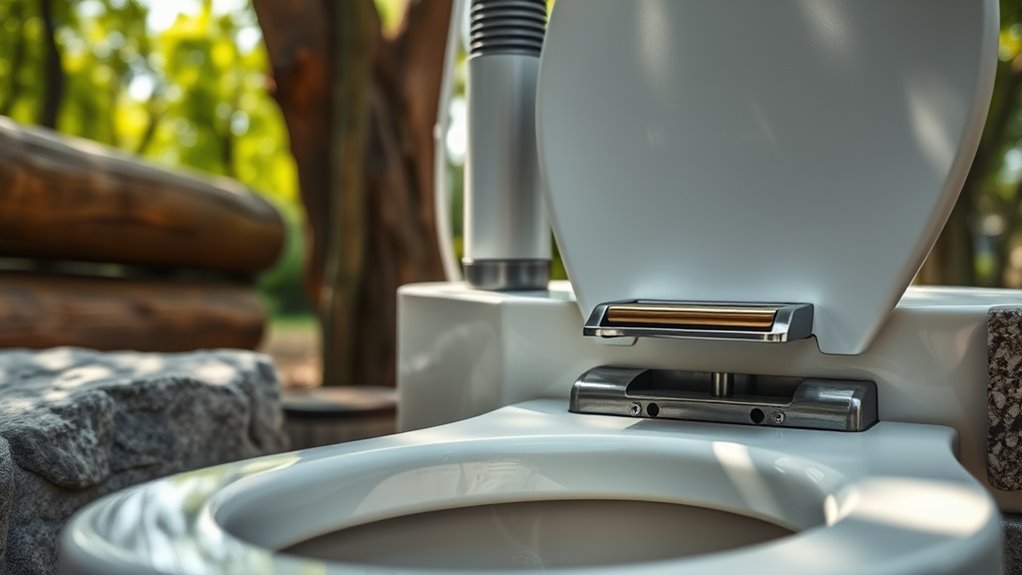
Composting toilets work by separating human waste from water and transforming it into compost through controlled biological processes. When you use one, biodegradable materials like peat moss, coconut coir, or sawdust are added to balance moisture and provide carbon. These materials help manage odor control by absorbing moisture and masking smells. The toilet’s design promotes aerobic decomposition, where microbes break down waste into compost safely and efficiently. As waste accumulates, it’s kept separate from liquids, reducing odor and mess. Proper layering of biodegradable materials encourages airflow, which further enhances odor control and speeds up composting. Additionally, understanding the Vortex concept can help optimize airflow and microbial activity to improve composting efficiency. Over time, this process produces nutrient-rich compost you can use for plants, making the entire system environmentally friendly and sustainable for travel or off-grid living.
Benefits of Using Composting Toilets While Traveling
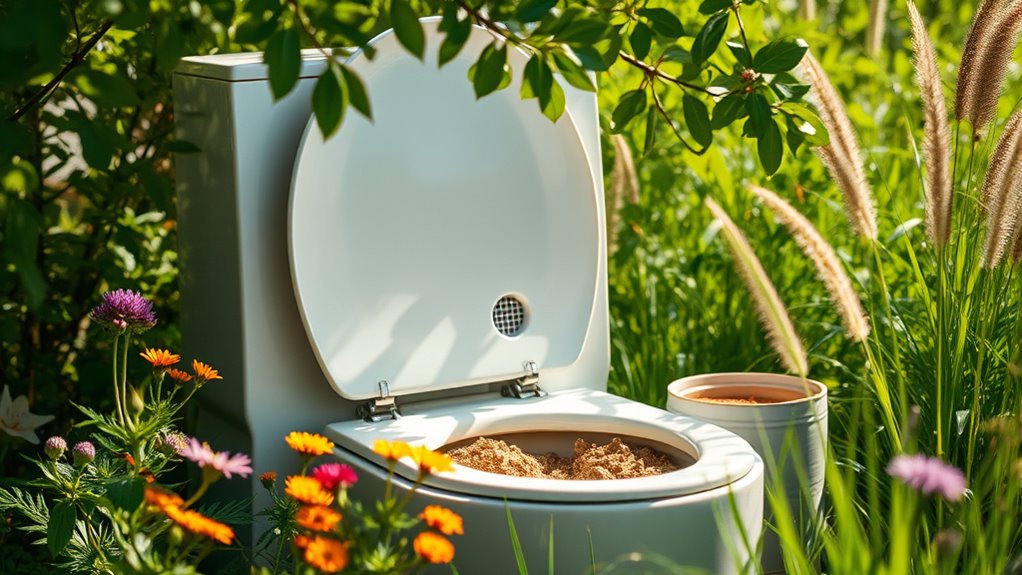
Using composting toilets while traveling helps you manage waste more sustainably and reduces your environmental impact. They conserve water, which is especially valuable in remote or resource-limited areas. Plus, you’ll contribute to eco-friendly practices that protect natural habitats and local communities. Incorporating advanced technology in composting systems can further improve efficiency and odor control, making them even more practical for travelers.
Eco-Friendly Waste Management
When you choose a composting toilet while traveling, you actively reduce your environmental impact by minimizing water consumption and waste that ends up in landfills or sewage systems. These toilets transform biodegradable waste into compost through the composting process, helping you manage waste responsibly. Using a composting toilet supports eco-friendly waste management by lowering pollution and conserving resources. Plus, it encourages proper waste separation, reducing the risk of contamination. Travel with confidence, knowing you’re making a positive difference for the environment. Proper storage and handling of waste is essential to maintain hygiene and efficiency in composting toilets.
Water Conservation Benefits
Choosing a composting toilet while traveling considerably boosts your water conservation efforts. These toilets often feature urine diversion, which separates liquid waste from solids, reducing water use and simplifying waste management. With water saving features built in, such as minimal flush requirements or no flush at all, you’ll use markedly less water than traditional toilets. This is especially beneficial in remote areas or places with limited water supplies. By reducing your water consumption, you help protect local resources and minimize your environmental impact. Composting toilets allow you to travel sustainably without sacrificing comfort or hygiene. They’re an effective solution for conserving water while maintaining sanitation standards. Additionally, fetal movements typically begin to be felt around 18-20 weeks, indicating healthy fetal development. Overall, using composting toilets helps you contribute to a more eco-friendly and responsible travel experience.
Types of Composting Toilets Suitable for Travelers

For travelers seeking a convenient and eco-friendly sanitation option, there are several types of composting toilets designed to meet their needs. Portable options are ideal for camping or RV travel, offering easy setup and mobility. Self-contained units combine the toilet and composting chamber in one, making them suitable for small spaces. Split-system toilets have separate composting chambers, often requiring minimal installation considerations. Vacuum or electric composting toilets use power to accelerate decomposition, perfect for off-grid adventures. Finally, seat-mounted composters are compact and lightweight, fitting easily into various settings. When choosing, consider how much space you have, your ease of installation, and whether you need a portable option for frequent travel or longer stays. Additionally, understanding the technology behind composting can help ensure you select a system that performs efficiently and sustainably, no matter where your travels take you.
Preparing to Use a Composting Toilet on the Road

Before hitting the road with your composting toilet, it’s essential to prepare properly to guarantee smooth operation and odor control. Start by choosing a suitable location with proper ventilation and access to waste disposal. Ensure your toilet meets sanitation standards to prevent contamination. Familiarize yourself with the setup process, including adding the right bedding material, like sawdust or peat moss, to manage moisture and odors. Keep a supply of waste disposal bags or compostable liners handy for easy cleanup. Use the table below to plan your supplies and practices:
| Item | Purpose | Tips |
|---|---|---|
| Bedding material | Odor control, moisture absorption | Use in recommended amounts |
| Waste disposal bags | Easy waste management | Seal tightly after use |
| Ventilation setup | Reduce odors | Ensure proper airflow |
| Cleaning supplies | Maintain sanitation standards | Regular cleaning |
| Spare parts | Prevent breakdowns | Carry essential replacements |
Additionally, understanding the environmental benefits of composting toilets can motivate proper usage and maintenance, ensuring you contribute positively during your travels.
Maintenance and Cleaning Tips for Composting Toilets
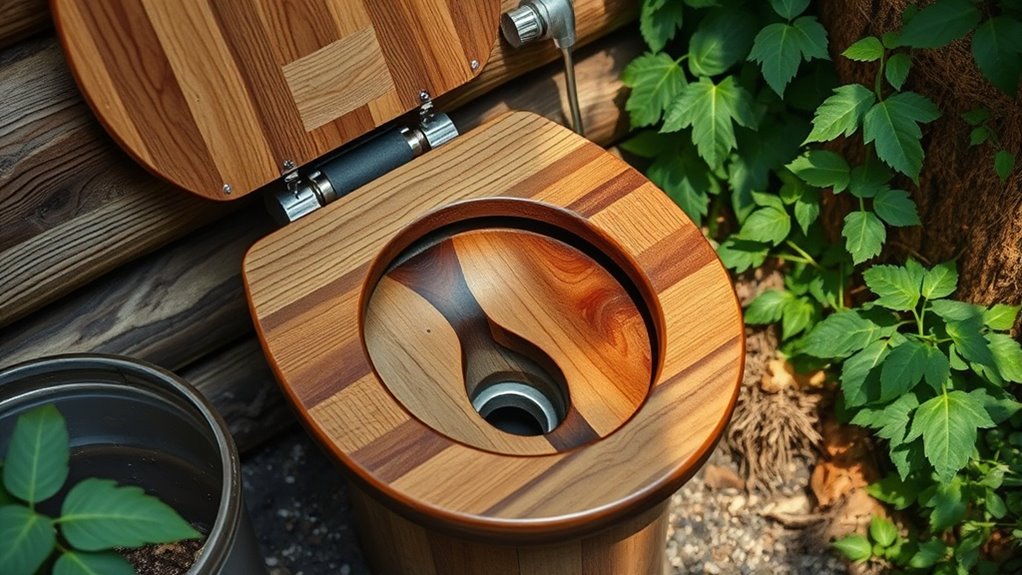
Regular maintenance and thorough cleaning are essential to keep your composting toilet functioning efficiently and smelling fresh. Setting a consistent cleaning schedule helps prevent odors and ensures proper waste disposal. Check the composting chamber regularly and add bulking agents like sawdust or coconut coir to maintain proper airflow and decomposition. Empty the waste container when it’s nearly full, following your specific waste disposal guidelines. Keep the ventilation system clean to avoid odors escaping. Use biodegradable cleaners and avoid harsh chemicals that could harm the composting process. Regularly inspect seals and hinges for leaks or damage. Proper hydration of the composting chamber, including adding moisture when necessary, supports effective composting cognitive function. Here are some tips to help you stay on track:
- Follow a regular cleaning schedule
- Use appropriate waste disposal methods
- Add bulking agents consistently
- Clean ventilation components
- Inspect seals and hinges periodically
Addressing Common Concerns and Myths
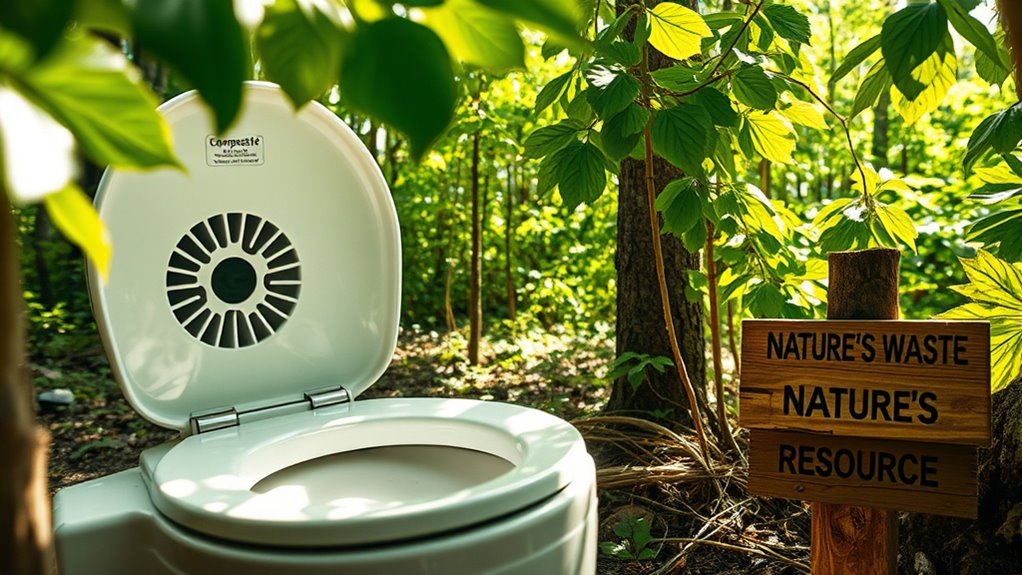
Many concerns and myths about composting toilets persist, but understanding the facts can help you make informed decisions and dispel misconceptions. Myth Busting reveals that these toilets are safe when used properly, and odor issues are minimal. Safety concerns often stem from misconceptions about bacteria or pathogens; in reality, composting processes reach temperatures that kill harmful organisms. Here’s a quick comparison:
| Myth | Fact | Explanation |
|---|---|---|
| Composting toilets are unsafe | They are safe when maintained | Proper composting kills bacteria |
| They smell terrible | They have minimal odor | Ventilation and proper use prevent odors |
| They attract pests | No, if sealed correctly | Sealed units prevent pests |
Understanding these facts helps you confidently use composting toilets without fear, especially considering proper maintenance is essential for their safe and effective operation.
Environmental Impact and Sustainability Benefits

Composting toilets not only address common concerns about safety and odor but also offer notable environmental advantages. By managing biodegradable waste naturally, they reduce your ecological footprint and conserve water. These systems eliminate the need for sewage treatment plants, lowering energy use and pollution. They transform waste into compost that can enrich soil, closing the nutrient loop. Additionally, composting toilets help protect sensitive ecosystems from contamination. Using them supports sustainable living and minimizes resource consumption. Incorporating sustainable practices into waste management further enhances their positive environmental impact.
Tips for Comfort and Convenience During Your Trip

When using composting toilets on your trip, staying comfortable and making things easy is key. You can improve your experience by knowing simple tips for managing odors, ensuring accessibility, and maximizing convenience. Using an air purifier with HEPA filtration can help reduce residual odors and improve air quality in your portable setup. Let’s explore how to stay fresh and comfortable wherever you go.
Portable Toilet Comfort Tips
To guarantee a comfortable experience with a portable toilet during your trip, it’s helpful to prepare in advance. Making sure your travel bathroom amenities include essentials like toilet paper, hand sanitizer, and a small mirror can greatly improve portable toilet comfort. Additionally, bring disposable wipes and a seat cover for added hygiene. Wearing comfortable clothing and bringing a small flashlight can make access easier in low light. Keep a supply of fresh water for rinsing if needed, and always carry a trash bag for disposal. These simple steps help you stay comfortable and confident using a portable toilet, making your trip more enjoyable. Proper planning ensures convenience and hygiene, so you can focus on your adventure without worry.
Managing Odors Effectively
Managing odors effectively is essential for maintaining comfort and freshness during your trip. To achieve this, focus on odor control by regularly adding composting materials like sawdust or coconut coir, which absorb odors and keep the composting process balanced. Proper ventilation strategies are also key; ensure the toilet has adequate airflow by opening vents or using small fans if available. When possible, position the toilet in a well-ventilated area or near an open window to help disperse odors quickly. Keep the lid closed when not in use to contain smells. Regular maintenance, including mixing and removing compost, prevents buildup and minimizes unpleasant smells. Using these odor control and ventilation strategies ensures your experience remains comfortable and odor-free throughout your trip.
Accessibility and Ease
Ensuring accessibility and ease of use in your composting toilet can substantially enhance your comfort during the trip. Look for models with accessibility features like step stools, grab bars, or adjustable seating to make use easier. A user-friendly design simplifies operation, reducing frustration and saving time. Familiarize yourself with the setup before your trip to guarantee smooth use. Keep essentials like toilet paper and hand sanitizer nearby for convenience. Regularly check the composting process to avoid any issues. Proper ventilation is key for comfort, so ensure the toilet has good airflow.
- Clear instructions and intuitive controls
- Ergonomic seat height
- Easy-to-reach flush or waste removal mechanisms
- Non-slip surfaces
- Compact, portable design
Frequently Asked Questions
Are Composting Toilets Legal to Use in All Travel Destinations?
You might wonder if composting toilets are legal everywhere. Legal restrictions and permitting requirements vary by travel destination. In some areas, they’re fully permitted and even encouraged for eco-friendly travel. However, in others, regulations may prohibit their use due to health concerns or local laws. Before you travel, check local regulations to guarantee you’re compliant. Always research permitting requirements to avoid fines or issues when using composting toilets abroad.
How Do I Dispose of Compost Without Creating Odors?
To dispose of compost without odors, you should focus on odor control and proper waste management. Seal the compost in an airtight container or bag to contain smells, and store it in a cool, dry place. Regularly aerate the compost to speed up decomposition and reduce odor. When ready, follow local guidelines for disposal or composting, ensuring you’re managing waste responsibly and minimizing unpleasant smells.
What Safety Precautions Should I Take While Handling Composting Toilet Waste?
Handling composting toilet waste is like tending a delicate garden; you need proper hygiene practices to protect yourself. Wear gloves and masks, and always wash your hands afterward. Make certain waste containment is secure to prevent leaks and odors. These precautions keep you safe and maintain cleanliness, just as a gardener safeguards their plants. By respecting these safety steps, you create a safer environment for yourself and your surroundings.
Can Composting Toilets Be Used in Extreme Weather Conditions?
You can use composting toilets in extreme climate conditions, but you need to take into account insulation considerations to prevent freezing or overheating. In cold weather, insulate the toilet and venting system to keep temperatures stable. During hot weather, ensure proper ventilation to avoid odors and moisture buildup. With the right preparations, composting toilets work effectively in diverse climates, making them a reliable choice for travel in extreme weather conditions.
How Long Does Composting Take to Be Fully Processed?
Ever wondered how long it takes for compost to be fully processed? The decomposition timeline varies based on factors like temperature, moisture, and materials, but typically, compost reaches maturity in 6 to 12 months. During this period, the compost matures, breaking down into nutrient-rich soil. Patience is key, as well as maintaining proper conditions, to guarantee your compost is safe and fully processed before use.
Conclusion
With wise words and well-worn ways, embracing composting toilets can transform your travels. By balancing basics, busting myths, and boosting eco-friendly efforts, you’ll breeze through your journey with confidence. Comfort, convenience, and conservation come together in this clean, conscious choice. So, seize the sustainable solution, stay spirited on the road, and savor the simple joy of responsible, reliable sanitation wherever your adventures take you. Safe travels, and happy composting!

